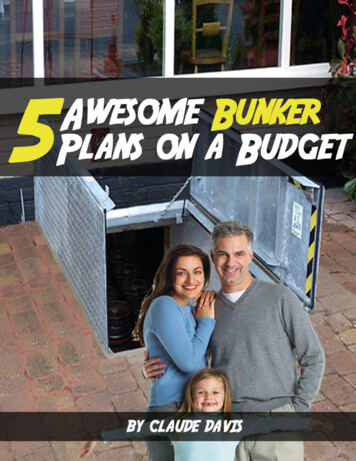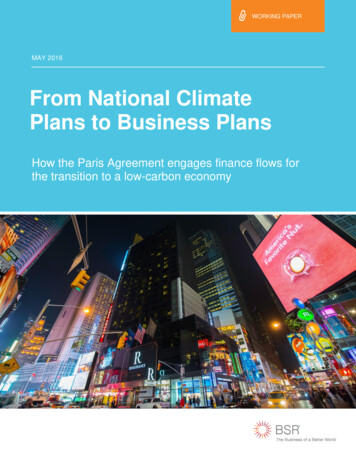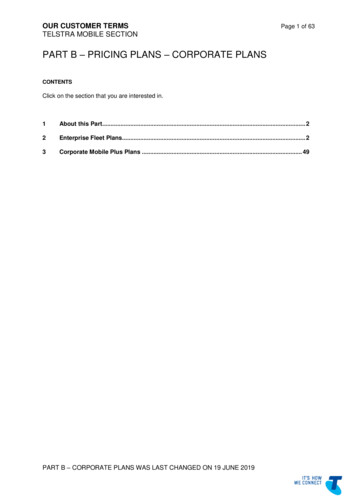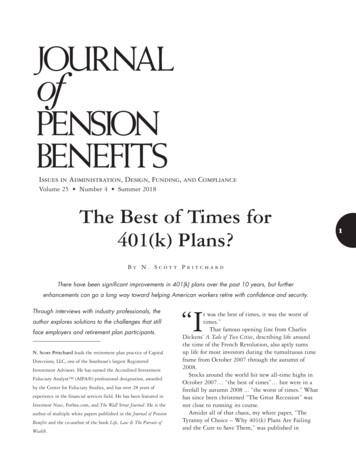
Transcription
5 Awesome Bunker Plans on a Budget1
5 Awesome Bunker Plans on a BudgetContentsIntroduction: . 3Glossary of Items Common to Bunker Plans . 5Plan #1: The Low-Cost Budget Bunker . 8Dimensions to Plan for and Be Aware of: . 10Plan #2: The Cheap Bunker . 14Plan #3: A Cheap and Easy Travel Trailer/BusBunker . 20Plan #4: The Above Ground Bunker . 27Plan #5: A Long Term, High Tech,Nuclear/EMP/Bio-Weapon Hardened Bunker. 33Building the Deluxe Survive-All Bunker . 36Conclusion . 412
5 Awesome Bunker Plans on a Budget5 Awesome BunkerPlans on a BudgetIntroduction:The world has reached a point unlike any other in history.Population density and growth has created not just one butseveral environmental crisis, of which we have already begun tosee the effects of, such as radiation and animal die-offs fromFukushima, sink holes in Oregon and the chemical spill inColorado which has contaminated a major river. Agriculturehas reached an all-time low with less people participating infood production than ever before in history and American3
5 Awesome Bunker Plans on a Budgetagriculture shrinking each year. Things just aren’t as safe asthey used to be which has you thinking it’s time to create a fewextra options.“I know that having a nuclear bunker might sound like toomuch, even for the most dedicated preppers. But this is onlybecause things are going well now. In a time of war, havingaccess to a nuclear bunker won’t sound weird at all. And intimes of peace, it can be used as a tornado shelter, a hideout,or a root cellar.”Before you build your bunker you will need to sit down andconsider your needs very carefully. A bunker can be a saferefuge to protect you from the big “event” or it could be justend up being an elaborate coffin. You will need to ask yourselfthe following questions:- How long do I anticipate sheltering? With how manypeople?- Does my environment have issues like salt corrosion,flooding, harsh winters, or extreme temperatures?- How much space will I need in relation to anticipated timespent inside?- How will I communicate with the outside world?- How defensible is my position? Will I be vulnerable tooutside intrusion? And, do I have a secondary fallback orescape plan?- How will I defend against seismic events such as volcanoesor earthquakes?4
5 Awesome Bunker Plans on a Budget- What kind of survival culture will I need in the event thatthe disaster leads to a long term survival situation? Foodcultivation, foraging and hunting may become necessary.You can never rely 100% on any one plan for the disaster whichmay hit you. For each primary choice you should have asecondary and tertiary option. Safety features such as firecontrol and emergency escape hatches should be plannedahead of time. A bunker is primarily for a short term storm orevent. Long term survival will eventually at some point requireyou to venture outward for food or even defense. Once yourbunker is finished you should do a dry-run practice with yourfamily to see if everything you need is available. Spend a day, afew nights or even a week inside your bunker to get a feel forhow things are going to pan out. Don’t forget entertainmentoptions either. A few decks of playing cards, pencils and paperand a few books can go a long way in occupying your time forthe duration of your stay.Glossary of Items Common to Bunker PlansSump Pump: A small 1/3 horsepower pump installed inhomes with basements, underground storage or undergroundbuildings. Any structure underground will need to havedrainage or a sump pump to keep them dry. Place a 30-gallonbarrel in the lowest point of your hole nestled down in the peagravel. Ensure that you have an uninterruptable power sourcesuch as a generator, solar or batteries to run this pump for theexpected duration of an emergency event.5
5 Awesome Bunker Plans on a BudgetCost: Between 300 - 2,500 DollarsFrench Drain: A gravity fed drain used to move standing wateraway from problem areas like buildings or garden areas. Agreat off-grid solution to high water table issues like standingwater and seepage.1. Find a run-off point that is lower than the lowest point ofyour basement or underground structure. This is where youwant the groundwater to go via gravity.2. Create a trench from the problem area to the run-off spot.You should slope down one inch for every 10 inches of run.(1”/10”)3. Line with landscape fabric or anything which will retainmud/earth without breaking down over time.4. Line with 2-3 inches of gravel.5. Place a pvc pipe with holes in it, downward towards thegravel on top of your cloth or mesh retaining fabric.6. Fold any additional retaining fabric or mesh over the top ofthe pipe and backfill dirt.Now your French Drain is ready to move the water out of theproblem area and into the nearest runoff area.Average Cost: 25/footPea Gravel Base: In most bunker/underground spaces youwill need to lay down a 6” bed of pea gravel to help lend to6
5 Awesome Bunker Plans on a Budgetdrainage and stability. Shipping will add more expense unlessyou have your own truck. This is much cheaper than pouring aconcrete slab. Check local building supply stores for local costs.This can work into your French drain system and provide a baseto build on top of.Average Cost: 3-4/tonGabion Basket: Any structure which you plan to bury orcreate must have walls which can withstand hydraulic force onthe sides and varying amounts of pressure on top based ondepth and local geology. A Gabion basket is a wire mesh basketmeasuring 2’ wide and as long as your hole/walls. When filledwith river rock the basket creates a contained wall which canbe backfilled with sand/concrete to further stabilize thefortification.Average Cost: 35/cubic yardFaraday Cage: This should be a consideration for any type ofbunker you construct. A faraday cage is basically a shieldedgarage, cabinet, barrel or box, which you can use to storeelectronics. In the event of an EMP detonation over NorthAmerica or your respective country you won’t just lose your cellphone signal, your unshielded electronics will be permanentlyfried.1. The basic idea is to build it from non-conductive materials(wood, cardboard) and then wrap or seal it on all sides7
5 Awesome Bunker Plans on a Budgetwith a conductive material (aluminum foil or silver, forexample)2. Note: a Faraday cage/shield, will not protect against solarcoronal mass injections (or solar flare).3. Don’t forget to put aluminum tape around all of your doorseams as that is the weakest point.4. Once you have finished your Faraday cage, test it byplacing a radio signal inside. An easy test is to place yourcell phone inside and then call it. If it rings you aren’tshielded properly.Average Cost: Free up to thousands of dollars. It is impossibleto predict the cost effectively because you can create a smallone from items found around your home, to a medium sizecabinet or even the size of your entire bunker facility.Plan #1: The Low-Cost Budget BunkerA bunker can be made out of anything which is strong,stackable and will retain dirt. If your dirt is stable enough youcan dig a hole and pack your walls with river stones. The mostinexpensive material is cinderblock. Cinderblock is almosteverywhere in the world that buildings are built. In thedeveloping nations you may see concrete poured over bambooor rebar with bricks making up the wall and evenmud/straw/cow dung/bamboo combinations which can beadapted for below ground fortifications. If you have a housewith a basement you can make a few simple modifications to8
5 Awesome Bunker Plans on a Budgetcreate an in-home bunker/shelter space. Your cost is directlyproportional to the size of the room you will build and theaccessories you want to have inside. This is where the locationcomes into play the most. Each region of the world hasregional craft and culture adapted to the landscape andgeology combined with available materials. Try to find a localhandicraftsman or even eco-building classes which can give youvaluable advice and tips which will save you time and money. Afew of these ecologically sound, but dirt cheap methods mayinclude: tires, recycled bottles, and pounded dirt. Remember, itmust be able to withstand moisture and pressure. If you live ina tropical, high humid or rainy area, you need something whichwill breathe but withstand high moisture, over a period of time,against corrosion.Here is a planning flow for a simple cinderblock shelter /bunker. You can adapt these guidelines to your space andneeds.The biggest job is digging a hole or using a natural feature tocreate a shelter. Your cost is directly proportional to the size ofthe room you will build and the accessories you want to haveinside. The basic box itself will be fairly standard. Start with ahole 9 to 12 feet deep for a shelter, 8 feet wide, 8 feet tall, and10 feet long, then you will have a 4-foot cover. (8 ft. x 8ft. x10ft.) In a real pinch, even a foot and a half of cover will be okand you won’t have to dig as deep either. Digging by hand is9
5 Awesome Bunker Plans on a Budgetfree, but time consuming. Hiring an excavator is more costlybut very time-efficient.Dimensions to Plan for and Be Aware of:Hole depth: 12 ft.Total length: 12 ft.Width: 10 ft.The standard cinderblock block is 8” wide x 8” tall x 16” long,you must build to accommodate that size. For example, youwant a 10’ long room but you must actually make it almost 12’long to account for that 8” of width on either end where youwill be placing your bricks or cinderblocks for the wall.Foundation/Floor:A cement slab if you can afford it, packed dirt with wood orgravel surface if you can’t. The main thing for the floor level isdrainage. Use a French drain and/or a sump pump for this.Walls:Cinderblock. Two important things to remember about wallsand foundation: drainage and access. It won’t be zombie proofbut it will do in a pinch. As you lay your block you can pour itfull of concrete and put rebar inside each hole and pack withsticky mud, sand or sand/cement powder mix and then backfillit. This will create a pretty strong and resistant wall. See Image1.1 for dimensions and basic layout. Be sure to equip thestructure with a strong inward opening door.10
5 Awesome Bunker Plans on a BudgetCeiling Structure:Four feet of dirt above ceilings is best, but in a pinch you can doone and a half foot (1 ½ ft.) Be sure to pick a location which if itstarts raining it won’t just fill with water. The idea is to getsome wood for your rafters and overlay it with anything whichwill support weight. For the ceiling you should use 4 in. x 6 in.timbers a foot apart and a 1 1/8-inch plywood to support 4 feetof dirt. This is not recommended for extreme depths. Be sureto plan for ventilation. You can add an ordinary filter like theone which comes in a shop vacuum to help keep out dust andparticulate matter from entering. Be sure to account for tubingrunning up one side of the other to allow that air in, plus aneasy way to clean it and prevent blockages. To prevent erosion,be sure to have your topside seeded with grass or native plantsaccording to natural landscape.Interior:You must have some way to keep your room dry, moisturebreeds mold and can create bigger problems inside than thoseoutside. You also need storage. The minimalist solution is aroom for sitting/sleeping and one for food/water/medicinestorage. You will need a bucket with a detachable toilet seatand a lid for 1-2 days at a time. For more people, morebuckets, or more trips to the outside. Be sure to stock water (7liters per person/per day), MRE’s (Meals Ready to Eat),dehydrated foods and canned foods. This bunker plan may ormay not include the ability to cook or heat water. Beef jerky,11
5 Awesome Bunker Plans on a Budgetpeanut butter and nuts are great, inexpensive options forprotein and fat, but can store for long periods of time. Be sureto consult expiration dates on packaging. Plan for shelves tostore food, blankets, water, a weather radio, flashlight/lantern,batteries and a first aid kit. Folding chairs and cots, or pulldown bunks are good space saving options for overnight,multiple day use. Wet wipes are a great item to store for basichygiene. See Image 1.2.Estimated cost: 1,000 depending on what you already have to work with oruse, and labor for making it happen. With a bit of creativityyou can repurpose most of the interior items from second handstores or whatever you have in storage. Look around the housefor ways to reuse old stuff which you don’t “need.”Pea Gravel will cost you 3 to 4 dollars per ton. A standard fullsize pickup truck bed will hold up to 1,500 lbs if you use yourown vehicle or rent one. Check costs against delivery prices.A sump pump will cost 300-500 dollars if you stay on the lowend of the scale.French Drain is free or quite inexpensive if you have thematerials or can find recycled items. Otherwise you will pay 25 dollars per foot on the average.12
5 Awesome Bunker Plans on a BudgetFigure 1: Basic Bunker13
5 Awesome Bunker Plans on a BudgetFigure 2: Things to considerPlan #2: The Cheap BunkerIf you have a little bit of savings put back and want to get themost out of it, then I recommend something fairly simple likethis idea.Storage containers are revolutionizing greenconstruction in so many ways. From store’s, to homes, toanimal sheds, a container is a great pre-fab structure which canbe cut up and modified to fit your needs quickly. On a sidenote however, you will need to plan very carefully for waterdrainage, structural stability and humidity if you decide to putone of these in the ground in order to prevent bigger problems.Keep in mind that for a similar cost you can also do a larger14
5 Aweso
05.11.2017 · 2. Note: a Faraday cage/shield, will not protect against solar coronal mass injections (or solar flare). 3. Don’t forget to put aluminum tape around all of your door seams as that is the weakest point. 4. Once you have finished your Faraday cage, test it by placing a radio signal inside. An easy test is to place your











